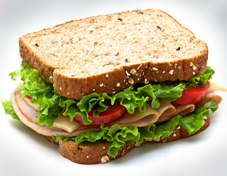Introduction
Sandwiches are a beloved staple in many diets around the world due to their versatility, convenience, and endless possibilities for customisation. Whether it’s a quick lunch on the go, a hearty dinner, or a creative snack and sandwiches can cater to any meal and occasion. Mastering the art of sandwich making can elevate your culinary skills and allow you to create delicious, satisfying meals that cater to your personal preferences. This guide will provide you with essential tips and tricks for making the perfect sandwich, from selecting the best bread to incorporating unique ingredients. Let’s dive into the world of sandwiches and discover how to craft the ideal bite.
Selecting the Best Bread

Choosing the right bread is the foundation of any great sandwich. The type of bread you select can significantly impact the texture, flavour, and overall experience of your meal. When selecting bread, consider factors such as texture, flavour, and durability. For example, soft bread like brioche or white sandwich bread may be ideal for delicate fillings, while hearty breads like sourdough or whole grain can hold up better to substantial fillings and add a robust flavour.
Whole grain bread is a nutritious choice that provides a good source of fibre and essential nutrients, making it perfect for health-conscious eaters. Sourdough, with its tangy flavour and chewy texture, pairs well with a variety of fillings and adds a gourmet touch to your sandwich. For those with dietary restrictions, gluten-free bread offers a suitable alternative without compromising on taste. Experimenting with different types of bread, such as baguettes, ciabatta, and pita, can also add variety to your sandwich repertoire and keep your meals exciting.
Ultimately, the key to selecting the best bread is to match it with your desired sandwich fillings and texture preferences. A well-chosen bread can enhance the flavours of your ingredients and provide a satisfying base for your creation. Don’t be afraid to try new breads and discover which one’s complement your favourite fillings best.
Crafting the Perfect Spread
Spreads play a crucial role in enhancing the flavour and texture of your meat sandwich. They add moisture, prevent dryness, and can elevate the overall taste profile. Popular spreads include butter, mayonnaise, mustard, hummus, and avocado. Each spread brings its unique flavour and texture, allowing you to customise your sandwich to your liking.
Butter is a classic choice that adds a rich, creamy texture and can help prevent the bread from becoming soggy. Mayonnaise, with its smooth and tangy flavour, pairs well with a wide range of ingredients, from deli meats to vegetables. Mustard, available in various types such as Dijon, yellow, and whole grain, adds a spicy kick and complements savoury fillings. Hummus, made from blended chickpeas, tahini, lemon juice, and garlic, is a nutritious spread rich in protein and fibre. Avocado, either sliced or mashed, provides a creamy texture and is packed with heart-healthy fats.
Creating your own custom spreads can also be a fun and rewarding way to personalise your sandwiches. Experiment with mixing herbs, spices, and other ingredients into your spreads to develop unique flavours. For example, adding roasted garlic to mayonnaise or mixing pesto and cream cheese can create exciting new taste sensations. Crafting the perfect spread is all about finding the right balance of flavours and textures to complement your sandwich fillings.
Balancing Flavours and Textures
Achieving the perfect balance of flavours and textures is essential for creating a satisfying sandwich. Combining sweet, savoury, spicy, and tangy ingredients can result in a complex and enjoyable taste experience. For example, pairing salty meats with sweet chutneys or pickles can create a delightful contrast. Similarly, adding a spicy element like jalapeños or a tangy component like pickled onions can elevate the flavour profile.
When considering textures, aim to include a variety of elements to keep each bite interesting. A good sandwich should have a balance of crunchy and creamy, soft and chewy. Incorporating ingredients like crispy lettuce, crunchy pickles, or toasted nuts can add a satisfying crunch. Creamy elements like cheese, avocado, or spreads provide a smooth texture that contrasts nicely with the crunchier components.
Examples of well-balanced sandwich combinations include a turkey and cranberry sauce sandwich, where the savoury turkey complements the sweet and tangy cranberry sauce, and the addition of crisp lettuce and creamy brie cheese adds texture. Another example is a roast beef and horseradish sandwich with caramelised onions and arugula, where the spicy horseradish and sweet onions balance the rich roast beef, and the arugula adds a peppery bite.
Balancing flavours and textures is an art that can be honed with practice and experimentation. Don’t be afraid to try new combinations and adjust ingredients to suit your taste preferences. A well-balanced sandwich is not only delicious but also a joy to eat.
Mastering Ingredient Layering
Layering ingredients properly is crucial for an evenly distributed flavour and texture throughout your sandwich. Start with a layer of spread on each slice of bread to add moisture and prevent the bread from becoming soggy. Next, add your main protein or filling, ensuring it is evenly distributed. Follow with any cheese, which can act as a barrier to keep wetter ingredients from soaking the bread.
Place vegetables and other fresh ingredients towards the top, ensuring they remain crisp and vibrant. For example, layer lettuce, tomatoes, and cucumbers above the cheese and protein to keep them fresh. If using condiments like mustard or mayo, spread them directly onto the vegetables to prevent them from making the bread soggy.
To prevent sogginess and ensure even distribution of flavours, consider the order of your ingredients carefully. Meats and cheeses should form the base, followed by vegetables and spreads. This layering technique helps maintain the integrity of the sandwich and ensures that each bite is balanced and flavourful. By mastering the art of layering, you can create sandwiches that are not only delicious but also structurally sound.
Using Fresh and Quality Ingredients
The quality of your ingredients can make or break your sandwich. Fresh, high-quality ingredients elevate the taste and overall experience of your meal. When selecting meats, cheeses, and vegetables, opt for fresh, local, and seasonal produce whenever possible. Fresh ingredients not only taste better but also provide more nutrients and are often more sustainable.
High-quality meats and cheeses, whether deli-sliced or freshly prepared, add richness and depth to your sandwich. Look for products free from preservatives and additives for the best flavour. Fresh vegetables, such as crisp lettuce, juicy tomatoes, and crunchy cucumbers, provide essential vitamins and minerals and add a refreshing contrast to heavier ingredients.
Sourcing local and seasonal produce can also enhance the flavour of your sandwiches. Local produce is often fresher and more flavourful, while seasonal ingredients are at their peak in terms of taste and nutritional value. Visiting farmers’ markets or local grocers can be a great way to find high-quality, fresh ingredients. By prioritising freshness and quality, you can create sandwiches that are both delicious and nutritious.
Grilling and Toasting Techniques
Grilling or toasting your sandwich can add an extra layer of flavour and texture, transforming a simple sandwich into a gourmet delight. Grilling melts the cheese, crisps the bread, and enhances the overall taste. Different methods of toasting include using a panini press, skillet, oven, or toaster.
A panini press is ideal for making hot, pressed sandwiches with evenly melted cheese and perfectly toasted bread. If you don’t have a panini press, a skillet can be used to achieve a similar effect. Heat the skillet over medium heat, add a small amount of butter or oil, and cook the sandwich until golden brown on both sides. Using an oven or toaster oven is another excellent method for toasting open-faced sandwiches or when you want to toast the bread before adding the fillings.
Grilling techniques can also vary depending on the type of sandwich. For example, a grilled cheese sandwich benefits from low and slow cooking to ensure the cheese melts without burning the bread. Meanwhile, a panini with hearty fillings may require higher heat to achieve the desired crispiness. Experimenting with different grilling and toasting methods can help you find the perfect technique for each type of sandwich.
Adding Creative and Unique Ingredients
Incorporating creative and unique ingredients can take your sandwiches to the next level and introduce new flavours and textures. Unconventional ingredients such as pickled vegetables, exotic cheeses, fruits, and specialty sauces can add a gourmet touch to your sandwiches.
Pickled vegetables like pickles, kimchi, or pickled onions add a tangy and crunchy element that pairs well with rich and savoury fillings. Exotic cheeses such as blue cheese, goat cheese, or brie can provide a distinctive flavour that elevates your sandwich. Fruits like apple slices, figs, or pears add a sweet and refreshing contrast to savoury ingredients.
Specialty sauces and spreads, such as sriracha mayo, pesto, or tzatziki, can also bring unique flavours to your sandwich. These ingredients not only enhance the taste but also add complexity and depth. When incorporating creative ingredients, consider how they complement the existing flavours and textures in your sandwich. The key is to experiment and find combinations that excite your palate.
Sandwich Presentation and Plating
Presentation plays a significant role in the overall enjoyment of your sandwich. A well-presented sandwich is more appetising and can enhance the dining experience. Tips for making your sandwich visually appealing include careful cutting, arranging, and garnishing.
Cutting your sandwich neatly, whether in halves, quarters, or diagonally, can make it easier to eat and more visually appealing. Arranging the ingredients so they are visible and layered attractively can also enhance the presentation. Adding a garnish, such as a sprig of herbs, a side of pickles, or a colourful salad, can complete the look.
Plating your sandwich with attention to detail can make a simple meal feel more special. Use a clean, attractive plate, and arrange the sandwich and any sides thoughtfully. By paying attention to presentation, you can turn an everyday sandwich into a delightful dining experience.
Storing and Packing Sandwiches
Proper storage and packing are essential for keeping your sandwiches fresh and delicious, especially if you’re preparing them in advance. To maintain freshness, wrap your sandwiches tightly in cling film, reusable sandwich bags, or place them in airtight containers.
When packing sandwiches for work, school, or picnics, consider the ingredients that may cause sogginess. Keep wet ingredients like tomatoes or pickles separate and add them just before eating. Layering the sandwich properly, with spreads and condiments between drier ingredients, can also help prevent sogginess.
For longer storage, such as preparing for several days, freezing is an option for sandwiches without fresh vegetables or delicate ingredients. Freeze them individually wrapped and thaw as needed. Proper storage and packing techniques ensure your sandwiches stay fresh and enjoyable whenever you’re ready to eat them.
Customising Sandwiches for Special Diets
Adapting sandwich recipes to meet various dietary needs ensures that everyone can enjoy a delicious meal. For vegetarians and vegans, plant-based proteins like tofu, tempeh, and legumes are excellent choices. Adding a variety of vegetables and plant-based spreads like hummus or avocado ensures a balanced and satisfying sandwich.
For those following a keto or low-carb diet, replacing traditional bread with lettuce wraps or low-carb alternatives can help maintain dietary goals. Focus on high-fat, low-carb fillings such as grilled chicken, turkey, cheese, and healthy fats like avocado or mayonnaise. Gluten-free individuals can opt for gluten-free bread or wraps, and should be mindful of cross-contamination when preparing and storing their sandwiches.
Customising sandwiches for special diets involves understanding the dietary restrictions and finding suitable ingredient substitutions. Experiment with different ingredients and recipes to keep your sandwiches diverse and satisfying, ensuring that everyone’s dietary needs are met without compromising on taste.
Conclusion
Mastering the art of sandwich making involves selecting the right bread, crafting the perfect spread, balancing flavours and textures, and using fresh, quality ingredients. Grilling and toasting techniques, adding creative ingredients, and paying attention to presentation can elevate your sandwiches to gourmet levels. Proper storage and packing methods ensure your sandwiches remain fresh and delicious, while customising recipes for special diets makes them accessible to everyone. By following these tips and tricks, you can create delicious, satisfying sandwiches that cater to your personal preferences and dietary needs. Enjoy experimenting and discovering the endless possibilities that sandwiches offer.
Meta Description
Discover essential sandwich making tips and tricks, from selecting the right bread to balancing flavours and customising for special diets. Elevate your sandwich game!




Leave a Reply